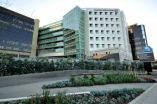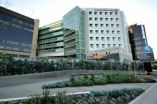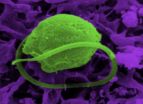(Press-News.org) Intent on developing wheat varieties with higher yields and enhanced nutritional content, researchers at the University of California, Davis, have teamed up with scientists at nine other institutions in an attempt to sequence the wheat genome.
Results from that endeavor, led by researchers at the U.K.-based Biotechnology and Biological Sciences Research Council, will be reported Nov. 29 in the journal Nature.
"This work moves us one step closer to a comprehensive and highly detailed genome sequence for bread wheat, which along with rice and maize is one of the three pillars on which the global food supply rests," said Jan Dvorak, professor of plant sciences at UC Davis and a study co-author.
"The world's population is projected to grow from 7 billion to 9 billion by 2050," he said. "It is clear that, with no new farmable land available to bring into cultivation, we must develop higher-yielding varieties of these three cereals to meet the growing global demand for food."
The bread wheat genome is especially complex because bread wheat originated from three ancient grass species. Its genome is, therefore, a composite of three genomes — and is five times the size of the human genome.
Wheat geneticists have historically designated the genomes of those parent grasses as the A, B and D genomes, each containing a similar set of genes. As a result, most bread wheat genes exist in triplicate.
To aid the sequence assembly of bread wheat, Dvorak and the UC Davis researchers have worked with scientists at the U.S. Department of Agriculture's Agricultural Research Service and with scientists at two other U.S. institutions on sequencing of the genome of the parent species Aegilops tauschii — the source of the bread wheat D genome.
The U.S. team shared the Aegilops tauschii sequences with the British team, which was assembling all three of the wheat A, B and D genomes.
Comparing the Aegilops tauschii sequence with modern wheat allows researchers to assess genomic changes that have taken place in bread wheat since its origin approximately 8,000 years ago.
In the study reported in Nature, the researchers used the whole genome "shotgun sequencing" approach, which generates billions of random genome sequence "reads" and then pieces them together. The results provide information about the DNA making up wheat genes that will help wheat breeders develop hardier varieties by linking genes to key traits, such as disease resistance and drought tolerance.
"This sequencing effort has yielded important information that will accelerate wheat genetics and breeding and help us better understand wheat evolution," Dvorak said. "It cannot be overemphasized, however, that this is just one step in the global effort to produce a high-quality draft of the bread wheat genome sequence."
He said completion of such a high-quality genome sequence for bread wheat is still a few years away and will require broad international collaboration to complete.
INFORMATION:
Other members of the UC Davis team included Ming-Cheng Luo, Patrick E. McGuire and Frank M. You, all of the Department of Plant Sciences. The USDA team also included two UC Davis research affiliates — Olin D. Anderson and Yong Gu — at the USDA Agricultural Research Service Western Regional Research Center in Albany, Calif.
The other collaborating institutions were Kansas State University; Cold Spring Harbor Laboratory, New York; University of Liverpool; University of Bristol; John Innes Centre; and European Bioinformatics Institute.
Funding for the study was provided by the Biotechnology and Biological Sciences Research Council of England, the USDA's National Institute of Food and Agriculture, The Royal Society, the German Ministry of Education and Research, and the National Science Foundation.
About UC Davis
For more than 100 years, UC Davis has engaged in teaching, research and public service that matter to California and transform the world. Located close to the state capital, UC Davis has more than 32,000 students, more than 2,500 faculty and more than 21,000 staff, an annual research budget of nearly $750 million, a comprehensive health system and 13 specialized research centers. The university offers interdisciplinary graduate study and more than 100 undergraduate majors in four colleges — Agricultural and Environmental Sciences, Biological Sciences, Engineering, and Letters and Science. It also houses six professional schools — Education, Law, Management, Medicine, Veterinary Medicine and the Betty Irene Moore School of Nursing.
Media contact(s):
-- Jan Dvorak, Plant Sciences, (530) 752-6549, jdvorak@ucdavis.edu
-- Pat Bailey, UC Davis News Service, (530) 752-9843, pjbailey@ucdavis.edu
END
A combination of anti-HIV drugs has been found to also reduce the risk of recurrent malaria by nearly half among HIV-positive children, according to researchers supported by the National Institutes of Health.
The combination of protease inhibitors lopinavir and ritonavir contributed to an overall reduction of 40 percent in the rate of malaria among a group of HIV-positive infants and children up to 6 years old in Uganda who were also being treated with anti-malarial drugs. This reduction was in comparison to malaria incidence among children receiving a drug treatment ...
Scientists at the Johns Hopkins Kimmel Cancer Center have combined the ability to detect cancer DNA in the blood with genome sequencing technology in a test that could be used to screen for cancers, monitor cancer patients for recurrence and find residual cancer left after surgery.
"This approach uses the power of genome sequencing to detect circulating tumor DNA in the blood, providing a sensitive method that can be used to detect and monitor cancers," says Victor Velculescu, M.D., Ph.D., professor of oncology and co-director of the Cancer Biology Program at Johns Hopkins.
A ...
A simple formula can predict at birth a baby's likelihood of becoming obese in childhood, according to a study published today in the open access journal PLOS ONE.
The formula, which is available as an online calculator, estimates the child's obesity risk based on its birth weight, the body mass index of the parents, the number of people in the household, the mother's professional status and whether she smoked during pregnancy.
The researchers behind the study hope their prediction method will be used to identify infants at high risk and help families take steps to ...
Scientists at the University of Liverpool have deciphered the genetic code of wheat to help crop breeders increase yield and produce varieties that are better suited to a changing environment.
Wheat is one of the world's most important food crops, accounting for 20% of the world's calorific intake. Global wheat production, however, is under threat from climate change and an increase in demand from a growing human population.
The Liverpool team, at the University's Centre for Genomic Research, used new methods of sequencing DNA to decode the large wheat genome, ...
Boys whose testes have not descended at birth—a condition known as cryptorchidism—are almost three times as likely to develop testicular cancer in later life, finds an analysis of the available evidence published online in Archives of Disease in Childhood.
The findings prompt the authors to ask whether boys with the condition should be regularly monitored to lessen the potential risk
Cryptorchidsim, where testes fail to descend into the scrotum and are retained within the abdomen, is the most common birth defect in boys, affecting around 6% of newborns.
The authors ...
Fort Davis, Texas — Astronomers have used the Hobby-Eberly Telescope at The University of Texas at Austin's McDonald Observatory to measure the mass of what may be the most massive black hole yet — 17 billion Suns — in galaxy NGC 1277. The unusual black hole makes up 14 percent of its galaxy's mass, rather than the usual 0.1 percent. This galaxy and several more in the same study could change theories of how black holes and galaxies form and evolve. The work will appear in the journal Nature on Nov. 29.
NGC 1277 lies 220 million light-years away in the constellation Perseus. ...
HOUSTON – A previously invincible mutation in chronic myeloid leukemia (CML) has been thwarted by an investigational drug in a phase I clinical trial reported in the current edition of The New England Journal of Medicine.
All 12 patients in the trial with chronic phase CML and the T315I mutation had a complete hematologic response (absence of CML cells in the blood) after treatment with ponatinib. Eleven had a major reduction in CML cells in the bone marrow and nine achieved a complete cytogenetic response – no cells in the marrow.
T315I is present in up to 20 percent ...
LOS ANGELES (Nov. 28, 2012) – Cedars-Sinai Heart Institute researchers have found in an initial clinical trial that a drug typically prescribed for erectile dysfunction or pulmonary hypertension restores blood flow to oxygen-starved muscles in patients with a type of muscular dystrophy that affects males, typically starting in childhood or adolescence.
Tadalafil, commonly known by brand names Cialis and Adcirca, reversed the effects of a biochemical chain of events that in Becker muscular dystrophy deprives muscles of an important chemical, nitric oxide, which normally ...
LOS ANGELES — EMBARGOED UNTIL 1 P.M. EST ON WEDS. NOV. 28, 2012 – Surgical teams at Cedars-Sinai have reduced surgical site infections by more than 60 percent for patients who undergo colorectal procedures by introducing evidence-based protocols that are easy to follow and relatively low in cost.
Surgeons, nurses, operating room staff and patients all collaborated in a quality improvement project that measured surgical site infection rates from March 2011 to March 2012. Several new steps were introduced to guard against infections, and these have now been expanded and ...
Microscopic animals held algae captive and stole their genes for energy production, thereby evolving into a new and more powerful species many millions of years ago reveals a new study published today in the journal Nature.
The results reveal a 'missing link' in evolution because the tiny animal thieves (protozoa) couldn't completely hide all evidence of the captive algae, and have been effectively frozen in time and caught in the act by genetic sequencing.
The protozoa captured genes for photosynthesis- the process of harnessing light to produce energy which is used ...



